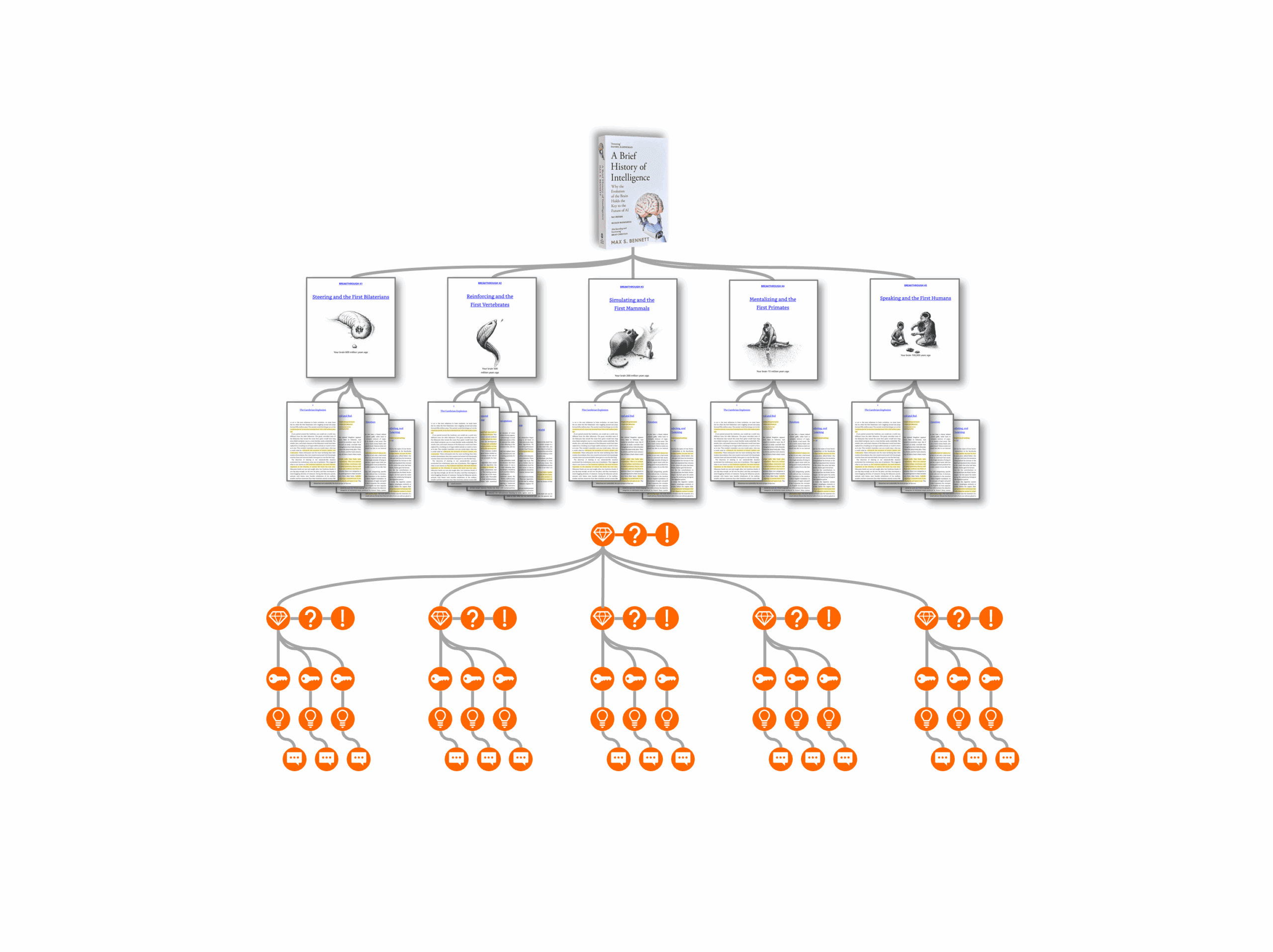Why Nested Summarization Is the Natural Way Your Brain Learns
Every great book is built like an architectural masterpiece. The title represents the overarching question or goal, chapters form the main pillars of argument, and sections provide the detailed evidence and examples. Nested Summarization leverages this inherent structure because it mirrors how your brain naturally processes and organizes complex information.
When you engage with a well-structured text, you're not just reading words—you're following chains of arguments carefully constructed by the author. These chains flow from broad questions to specific claims, from abstract concepts to concrete examples. The technique of Nested Summarization recognizes this flow and uses it as a learning advantage.
The fundamental principle is simple yet effective: decompose text into chains of arguments, then decompose those chains into their essential components. This approach transforms passive reading into active learning by forcing you to identify the logical structure underlying every piece of information.
As you move up each level of summarization, you use ever fewer words while those words contain exponentially more meaning. A single keyword at the top level can trigger recall of entire chapters because it's connected to a well-organized mental framework.
Essential Components of Nested Summarization
- Main Take-away: The single most important insight you gained from reading this content—whether it's the entire book, a specific part, or an individual chapter. This is your personal learning outcome—what fundamentally changed in your understanding after engaging with this material.
- Main Question: The central problem or inquiry that the content attempts to address. Every good book, part, or chapter is written to answer a specific question, and identifying this question helps you understand the author's purpose and evaluate their success.
- Main Claim: The author's primary assertion or thesis for this level of content—their answer to the main question. This is what they're trying to convince you of or the central point they're making throughout this section.
- Key Word/Key Term: The specialized vocabulary, concepts, or technical terms that are essential to understanding this particular content. These terms often carry heavy conceptual weight and serve as mental shortcuts to complex ideas.
- Idea/Concept: The theoretical frameworks, models, or explanatory principles that the author uses to support their claims at this level. These are the building blocks of understanding that connect the abstract to the concrete.
- Example/Evidence/Experience: The concrete illustrations, research findings, case studies, or personal anecdotes that the author provides to make their abstract ideas tangible and credible. These elements make concepts memorable and applicable.
How Nested Summarization Compares to Other Learning Techniques
While Nested Summarization shares DNA with several established learning methods, its unique bottom-up, structure-based approach sets it apart from more linear or top-down techniques.
Progressive Summarization (Tiago Forte)
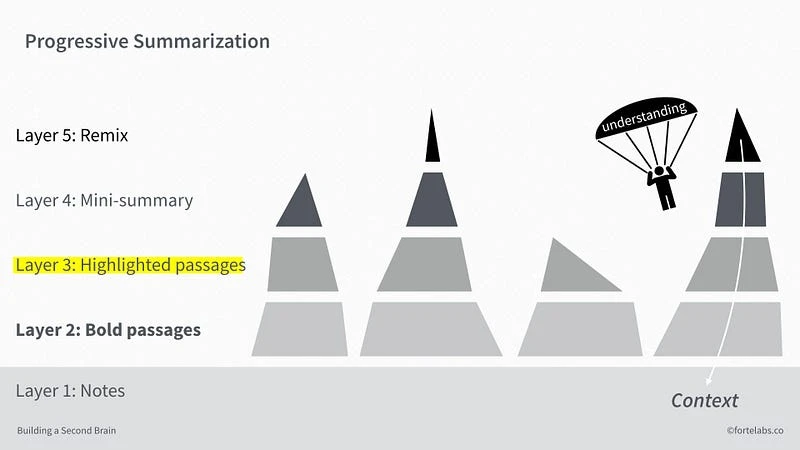
Tiago Forte's Progressive Summarization is a three-step linear process for distilling information: first capture information in your notes, then highlight the most important parts, and finally highlight the most important parts of your highlights. While effective for individual notes and articles, Forte's method doesn't leverage the hierarchical structure of longer works like books. Nested Summarization goes deeper by working with the author's intended logical flow and building summaries that respect and utilize the text's organizational architecture.
SQ3R Method (Survey, Question, Read, Recite, Review)
The SQ3R method is a systematic reading strategy where you first survey the entire text to get an overview, formulate questions about what you expect to learn, read through the material, recite key points to reinforce memory, and finally review everything to consolidate learning. The classic SQ3R method shares the questioning aspect with Nested Summarization, but approaches learning from the top down. You survey the entire text first, then read through systematically. Nested Summarization works in reverse—you build understanding from the bottom up, allowing the structure to emerge naturally as you work through detailed sections toward broader themes.
Cornell Note-Taking System
The Cornell Note-Taking System divides each page into three sections: a narrow left column for cues and questions, a wider right column for detailed notes during lectures or reading, and a bottom section for summarizing the page's main points. Cornell notes organize information into cues, notes, and summaries for each page or lecture. While this creates structure, it's primarily a linear, time-based organization. Nested Summarization creates a hierarchical, content-based organization that mirrors the logical structure of arguments rather than the sequence of information presentation.
Outline Method
The outline method organizes information hierarchically using headings, subheadings, and bullet points to show relationships between main ideas and supporting details. Traditional outlining and Nested Summarization both use hierarchical organization, but they serve different purposes. Outlining typically happens before or during initial reading to organize information. Nested Summarization happens after deep reading and focuses on distilling meaning rather than organizing facts. It's synthesis rather than analysis.
Concept Mapping
Concept mapping is a visual learning technique that represents knowledge by connecting concepts with labeled lines that describe their relationships, typically resulting in a web-like diagram that shows how different ideas relate to each other. Concept maps create visual representations of relationships between ideas, similar to the final mind map stage of Nested Summarization. However, concept mapping is typically used to explore connections across different topics or domains. Nested Summarization maintains focus on the internal logical structure of a single work, following the author's intended argument flow.
Feynman Technique
The Feynman Technique tests and improves understanding by explaining complex concepts in simple language, as if teaching them to someone with no background knowledge in the subject. The Feynman Technique focuses on explaining complex concepts in simple language to test understanding. While Nested Summarization includes this element, it goes further by organizing these explanations within the hierarchical structure of the original text. This preserves context and argument flow that pure explanation might lose.
Step-by-Step Guide to Mastering Nested Summarization
Step 1: Establish Your Foundation - Identify the Book's Architecture
After your initial in-depth reading, begin at the highest level. Ask yourself: "What is the single most important thing I learned from this entire book?" This becomes your personal main take-away—the core insight that will anchor all your subsequent summaries.
Next, identify the book's main question and main claim. What central problem is the author trying to solve? What's their primary assertion or thesis? These elements form the foundation of your understanding.
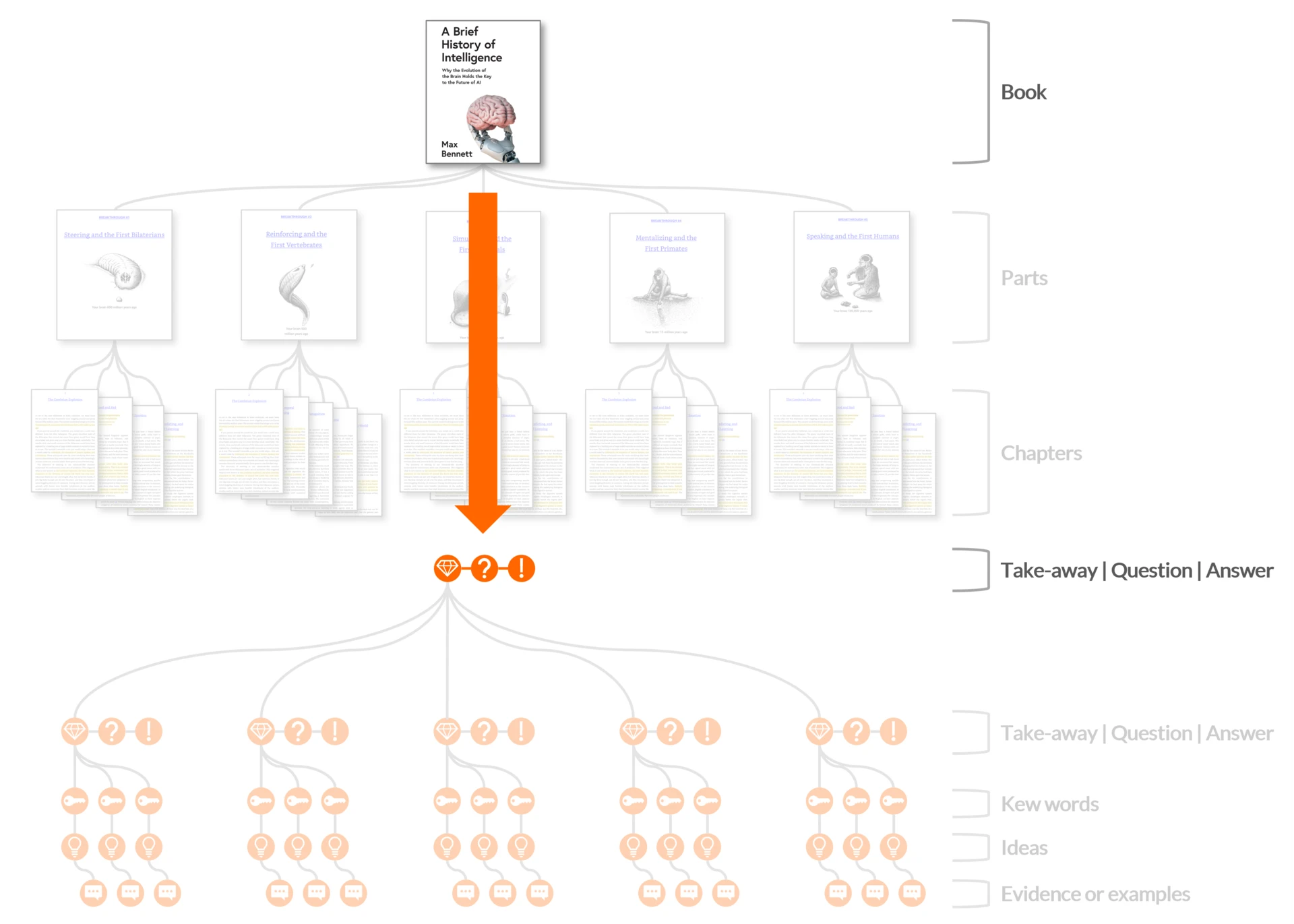
Most importantly, look for the book's overarching dimensions—the themes, perspectives, or analytical frameworks that repeat throughout different chapters. For example, in Max Bennett's "A Brief History of Intelligence," each section examines an evolutionary breakthrough through consistent lenses: the specific trick intelligence developed, when it emerged in evolutionary history, which life form first developed it, which brain region handles it in humans, and which AI technology employs similar logic.
These dimensions become your template for analyzing individual chapters, ensuring consistency and completeness in your nested summaries.
Step 2: Chapter-Level Analysis - Build Your Middle Layer
Now apply the same systematic approach to each chapter. For every chapter, identify:
- The chapter's main take-away (How does this chapter contribute to the book's overall argument?)
- The main question this chapter addresses
- The chapter's main claim or conclusion
- Key terms introduced or heavily used
- Core ideas and concepts explained
- Examples, evidence, or experiences provided to support the claims
Remember, you're decomposing each chapter into chains of arguments. Each argument flows from question to claim to supporting concept to concrete example. This creates a logical progression that makes the information easier to understand and remember.
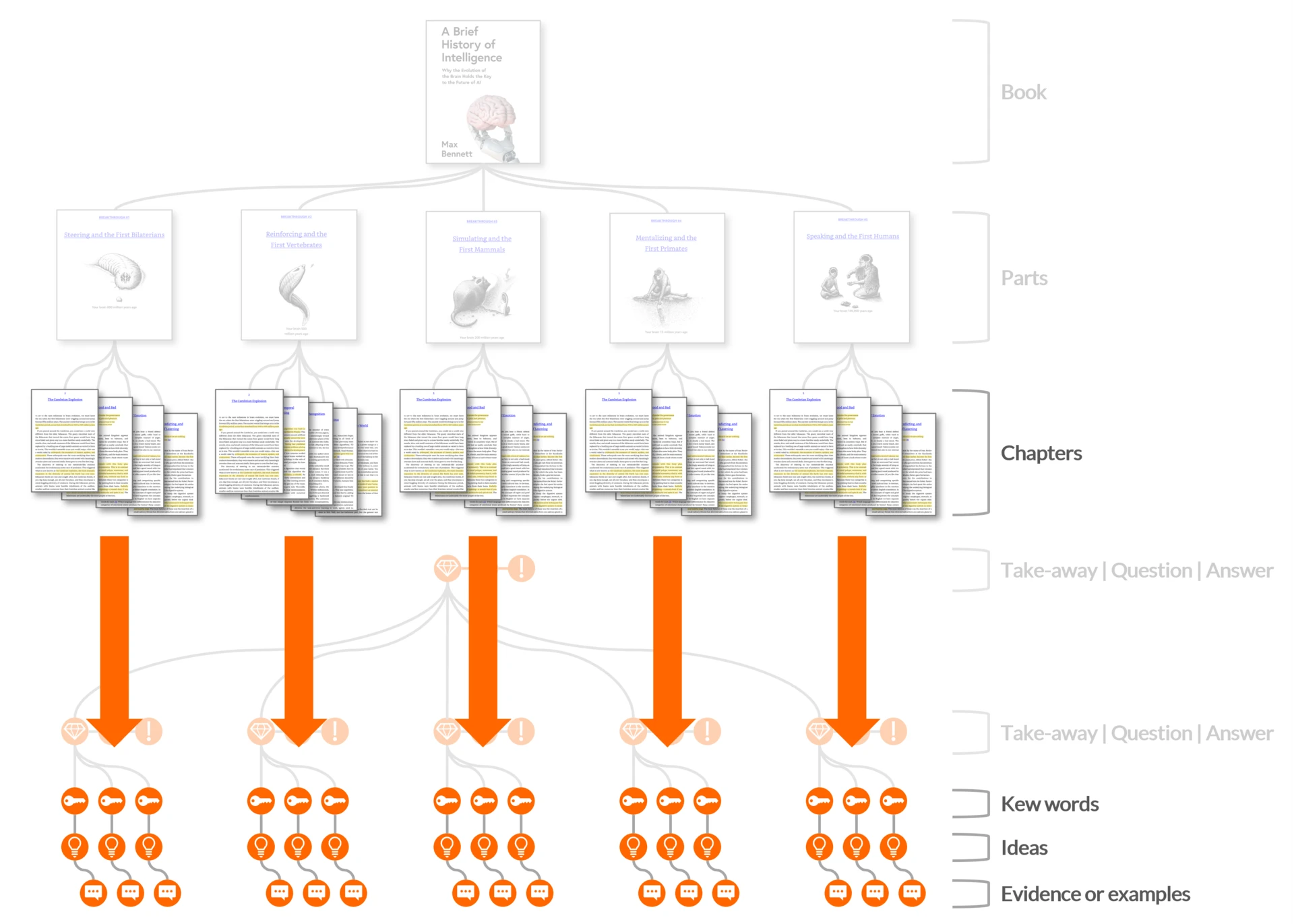
The goal at this stage is to summarize with ever fewer words while those words contain ever more content. Your chapter summary should be dense with meaning, where each word triggers recall of larger concepts and supporting details.
Step 3: Part-Level Synthesis - Connect the Major Themes
If your book has a multi-level structure (Parts containing Chapters, or Chapters containing Sections), repeat the same process at the highest organizational level. This step depends entirely on your book's architecture—some books only have chapters, others have elaborate hierarchical structures.
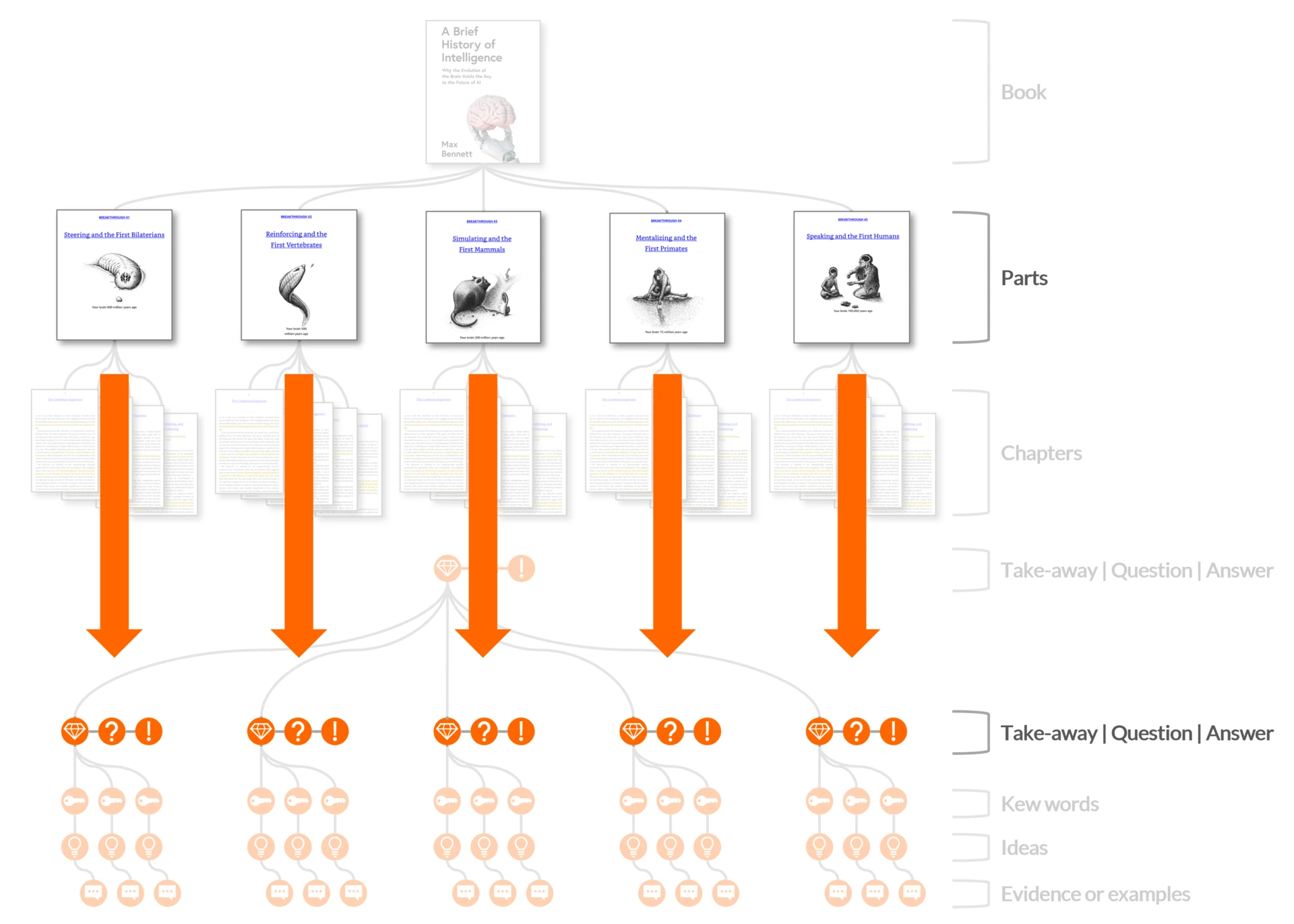
At this level, you're looking for how major sections relate to each other and contribute to the book's overall argument. Your part-level summaries should capture:
- How this part advances the book's central thesis
- The unique contribution of this section to the overall argument
- Key transitions and connections to other parts
- The most crucial evidence or insights from this section
This is where the hierarchical structure becomes most valuable—you can see how individual details in chapters serve larger purposes in parts, which in turn support the book's main argument.
Step 4: Create Your External Knowledge Graph
The final step transforms your nested summaries into a visual, external knowledge representation. This could be:
- A hierarchical mind map showing the tree-like structure from book title down to key examples
- A hand-drawn canvas with spatial relationships and visual connections
- A structured outline with clear indentation showing the hierarchical relationships
- A concept diagram showing how arguments flow and connect
This external representation serves multiple purposes: it documents your thinking process, provides a quick reference for future review, and creates a visual overview that helps you see patterns and connections you might have missed.
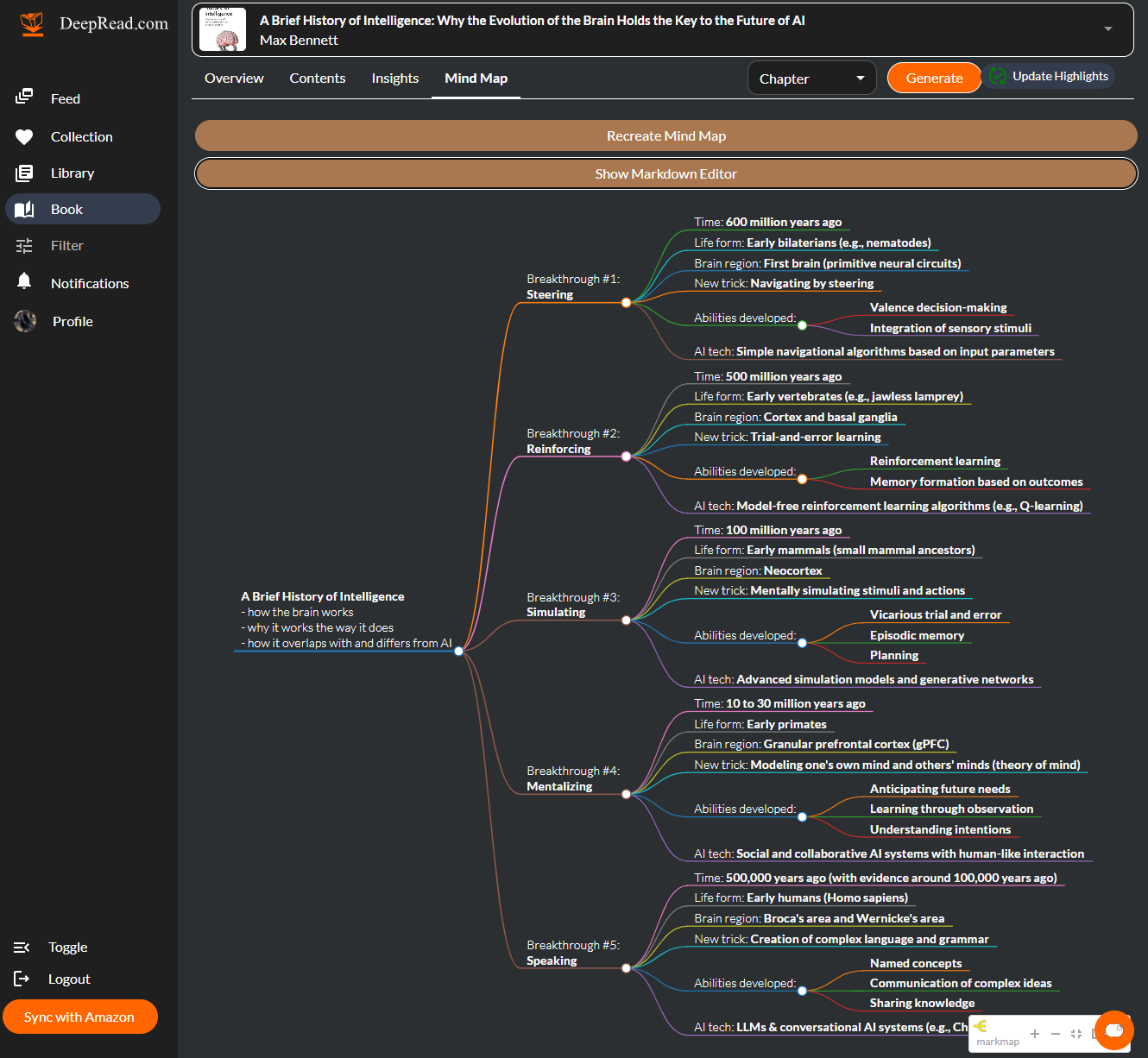
The key is that this external graph should allow you to "see" the entire book's content at a glance while providing pathways to recall detailed information when needed.
How DeepRead Supports Your Nested Summarization Journey
DeepRead is specifically designed to support every stage of the Nested Summarization technique, transforming what used to be a manual process into a seamless digital workflow.
Step 1: Import and Organize Your Foundation
After reading and highlighting your book (whether on Kindle or another platform), sync with DeepRead to import your highlights directly into the platform. Once imported, navigate to the "Overview" tab where you'll find a dedicated "Notes" section. This is where you document your book-level insights:
- Your personal main take-away from the entire book
- The book's central question and main claim
- The overarching dimensions you identified
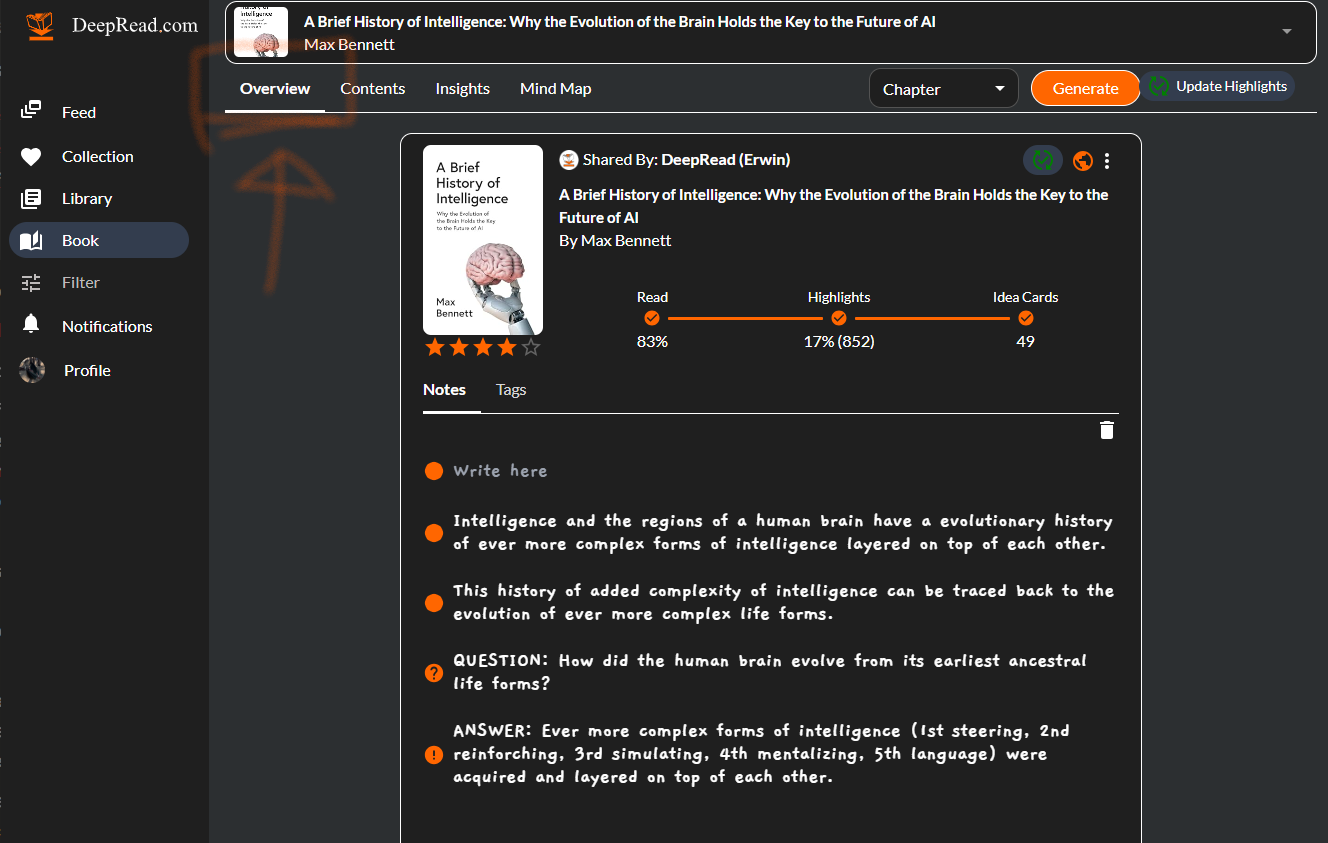
This creates a permanent record of your highest-level understanding that you can reference throughout your chapter-level analysis.
Step 2: Chapter-by-Chapter Analysis
DeepRead's "Contents" tab organizes your Kindle highlights nested within the book's chapter structure, making it perfect for systematic chapter analysis. Start by closing all chapters so you can focus on one at a time—this prevents cognitive overload and maintains focus.
For each chapter, work through your highlights systematically. When you identify key terms, questions, claims, ideas, or examples, select them with the app's cursor and press "Enter" to create flashcards. This transforms passive highlights into active learning tools while maintaining their hierarchical context within the book structure.

The flashcard system in DeepRead allows you to:
- Tag different types of content (concepts, examples, key terms)
- Add your own explanations and connections
- Create spaced repetition sequences for long-term retention
- Link related concepts across different chapters
Step 3: Higher-Level Structure Analysis
For books with multiple structural levels, repeat the same process at the part or section level. DeepRead maintains the full hierarchical structure of your book, and you can collapse entire book sections and reopen single parts or chapters for more focused analysis. This feature prevents cognitive overload by allowing you to work at whatever level of detail the book's organization supports.

By collapsing and expanding different sections systematically, you can identify patterns across chapters and parts, making it easier to recognize those crucial overarching dimensions that tie the whole book together.
Step 4: Visual Knowledge Graph Creation
DeepRead's "Mind Map" tab provides the perfect tool for creating your external knowledge representation. The platform generates an AI-powered initial mind map based on your highlights and notes, but the real power comes in customization.
Using the "Markdown Editor" button, you can:
- Adjust the hierarchical structure to match your nested summaries
- Add connections between related concepts
- Include your personal insights and take-aways
- Create visual pathways that reflect the book's argument structure
- Collapse and expand different sections to focus on specific areas while maintaining the overall structure
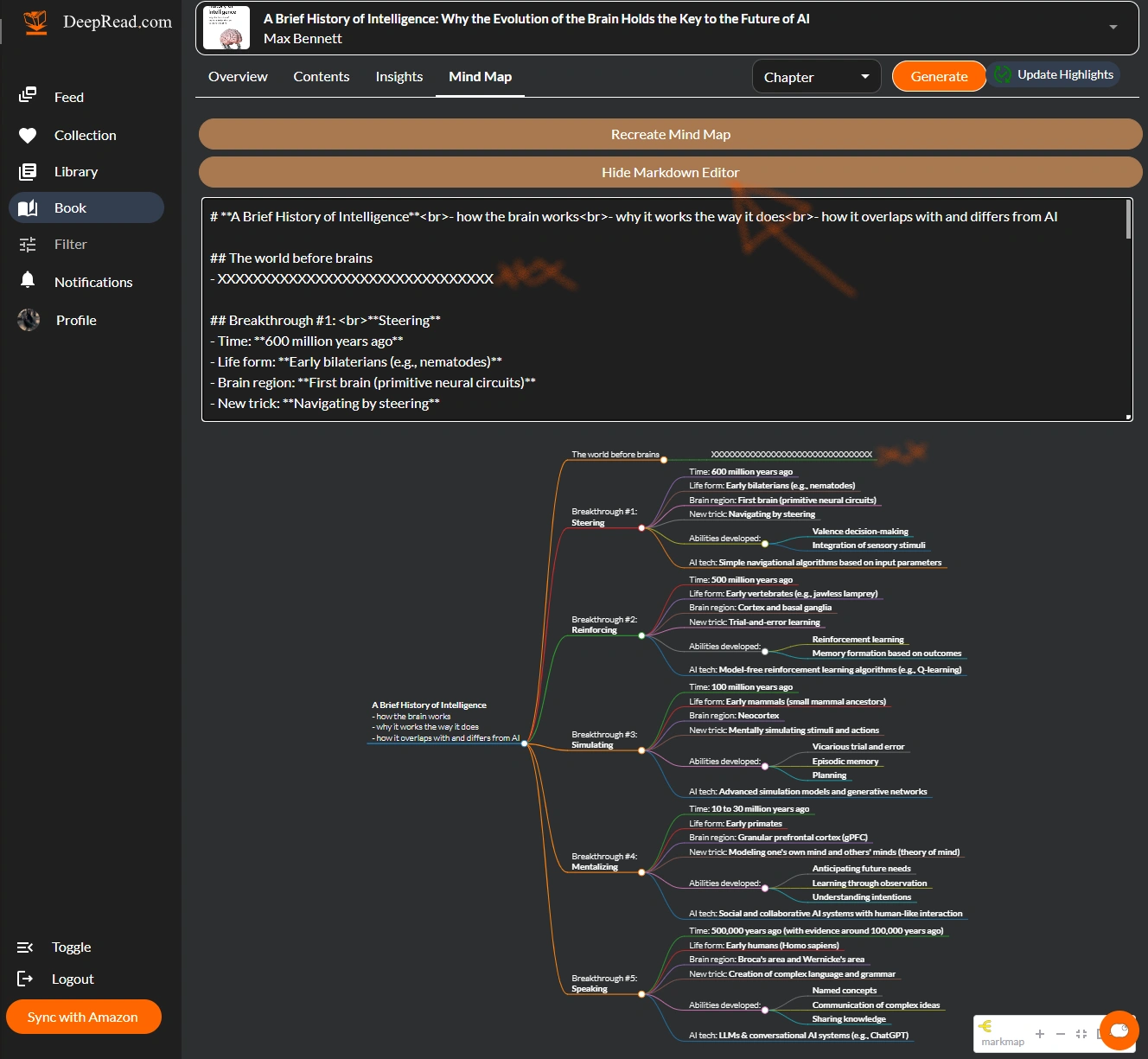
This mind map becomes your permanent documentation of both the book's content and your learning process. It makes learning engaging while building your knowledge system, creating a resource you can return to months or years later for quick review or deeper exploration.
The combination of DeepRead's organizational tools with the Nested Summarization technique creates a powerful system for transforming passive reading into active knowledge building. It transforms reading from passive consumption to an active learning experience, making every book you read a building block in your expanding understanding of the world.
Your Next Steps: Implementing Nested Summarization
You now have everything you need to transform how you learn from books. Nested Summarization isn't just a technique—it's a mindset shift that recognizes the natural way your brain wants to organize complex information.
Start small with your very next book:
- Choose a book with clear chapter divisions (avoid complex multi-level structures for your first attempt)
- After reading, identify just the main take-away, main question, and main claim for the entire book
- Pick your three most important chapters and create simple summaries using the six components
- Create a basic visual representation—even a hand-drawn outline will work
Build your practice gradually: As you become comfortable with the basic pattern, start working with more complex books and deeper levels of analysis. Add tools like DeepRead to streamline your process, but remember that the technique itself is more important than any specific tool.
Make it a habit: The students and lifelong learners who benefit most from Nested Summarization are those who apply it consistently. It becomes not just a study technique, but a way of thinking about information, arguments, and knowledge itself.
Every book you read using Nested Summarization doesn't just add to your knowledge—it strengthens your ability to learn from every future book. You're not just studying; you're developing the meta-skill of learning how to learn.
The technique you've just learned is already used intuitively by successful students worldwide. Now you have the framework to apply it systematically, turning an unconscious habit into a deliberate learning strategy.
